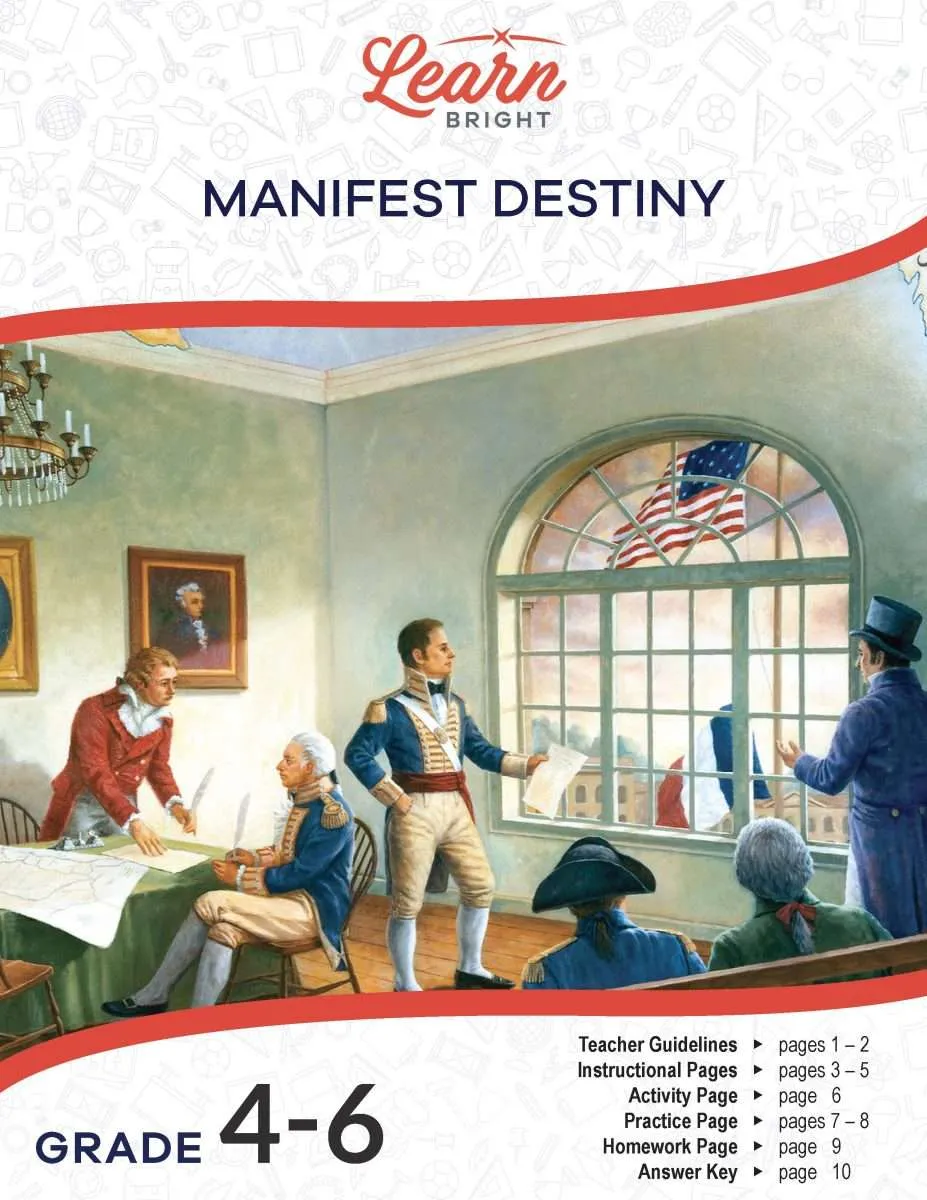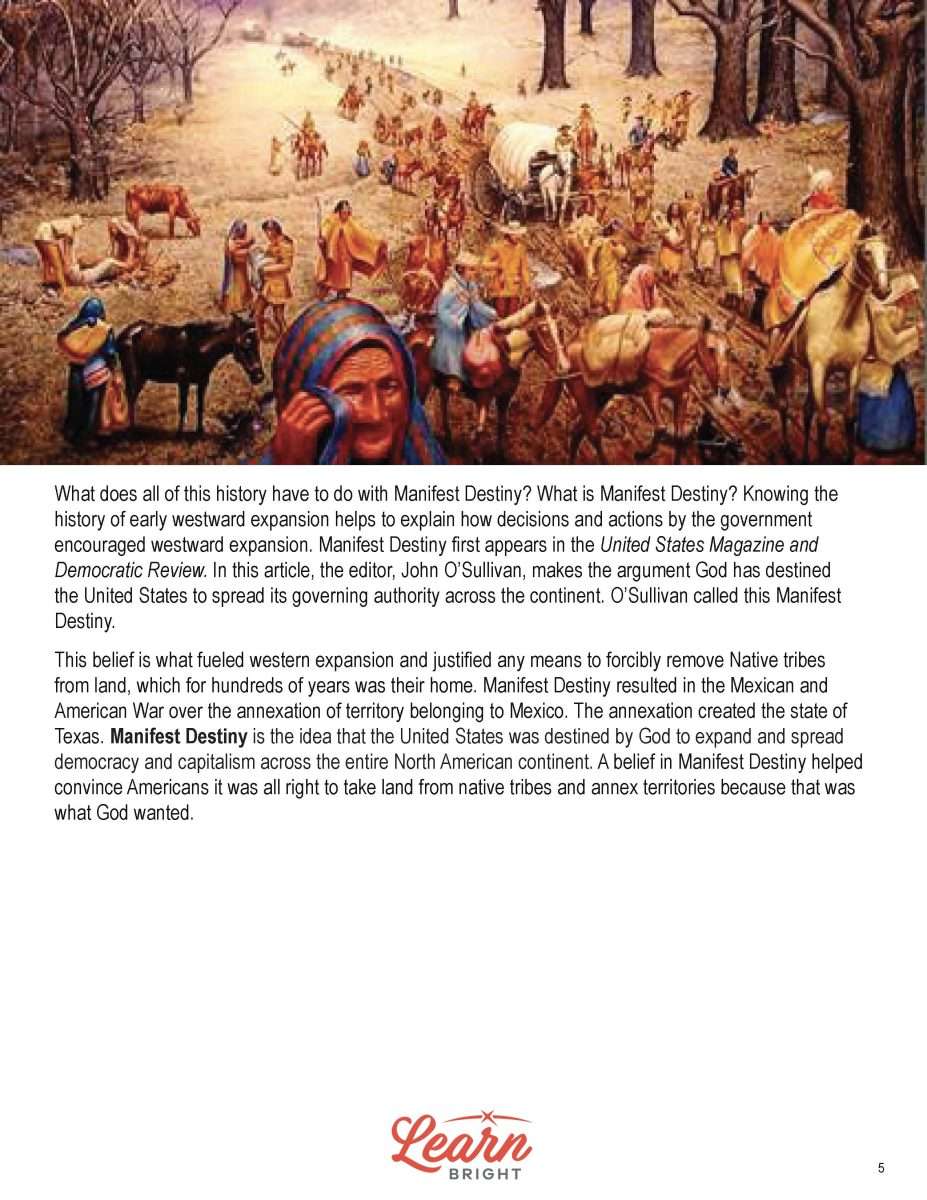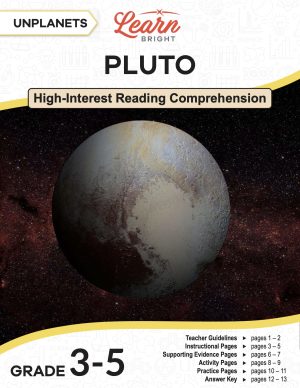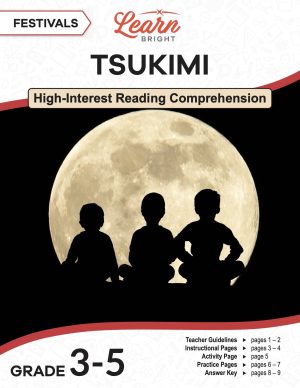Description
What our Manifest Destiny lesson plan includes
Lesson Objectives and Overview: Manifest Destiny teaches students about this unique mindset that influenced the expansion of the United States. Students will discover how the early settlers claimed a religious right to take over every part of North America. They will be able to define and explain the term. They will describe its impact and consequences on the US during the 1800s. This lesson is for students in 4th grade, 5th grade, and 6th grade.
Classroom Procedure
Every lesson plan provides you with a classroom procedure page that outlines a step-by-step guide to follow. You do not have to follow the guide exactly. The guide helps you organize the lesson and details when to hand out worksheets. It also lists information in the yellow box that you might find useful. You will find the lesson objectives, state standards, and number of class sessions the lesson should take to complete in this area. In addition, it describes the supplies you will need as well as what and how you need to prepare beforehand.
Options for Lesson
In the “Options for Lesson” section of the classroom procedure page, you will see some suggestions for additional activities or ideas to add to the lesson if you want to. Students may work alone or in groups for the activity. Distribute a map of the United States. Have students draw the lines of the different territories and states as they were in 1848. Students could research and present information related to people or ideas related to Manifest Destiny. Some ideas include President Polk, the Mexican-American War, the Oregon Territory, and religious fervor. Conduct a mock debate related to the concept. Half the class would be in favor of expansion, and the other half would be against it. One more activity is to have students create an essay, poem, song, journal entries, etc., that relates to Manifest Destiny and its impact on the country.
Teacher Notes
The teacher notes page provides an extra paragraph of information to help guide the lesson and remind you what to focus on. The blank lines on this page are available for you to write out thoughts and ideas you have as you prepare the lesson.
MANIFEST DESTINY LESSON PLAN CONTENT PAGES
What Is Manifest Destiny?
The Manifest Destiny lesson plan contains three pages of content. Destiny is the concept that the events that will happen or have happened to a particular person or thing is predetermined. For example, it might be your destiny to attend college one day because that is what your parents decide is best for you. Some people believe a person or groups of people may not have control over their destiny. In other words, they believe it is inevitable that a specific event will happen and is supposed to happen.
Manifest, as used with destiny, means something that is clear or obvious to the eye or mind. For example, it might be manifest destiny for you to one day attend college because the idea is very clear to you and your parents. There may be almost no doubt or question in your parents’ minds related to your future attendance at a college someday.
However, the term Manifest Destiny first showed up in 1845 by a New York newspaper writer named John L. O’Sullivan. He used the term to relate the idea that the United States, which was looking to expand, had a God-given right to take over every part of North America. This idea became popular. While not the official policy of the United States, it was used as the motivation for many people to believe the first white settlers in America were destined by God to take over all the land of the continent.
Students will learn that John L. O’Sullivan’s article urged support of the annexation (takeover or occupation) of Texas. His article appeared in a summer edition of the United States Magazine and Democratic Review. In the article, he wrote that it was America’s “manifest destiny to overspread the continent allotted by Providence for the free development of our yearly multiplying millions.”
Expansion of the US
Many people believed in the concept, including James K. Polk, who was elected president in 1845. He believed strongly in the idea, and during his presidency, the United States grew by a million square miles. He wanted to add the area that is now around Texas. At the time, Mexico had controlled that land.
The belief in Manifest Destiny encouraged people to go to other parts of the West as well, like Oregon and southern California. However, there were also other reasons, including the increase in the population of the young country, especially in cities. People wanted to have their own land instead of working for others. And others believed expanding westward would lead to prosperity and more money. The mixture of all these ideas along with Manifest Destiny caused the country to grow very quickly in just 40 years.
The first acquisition of land began in 1845 when the United States took over Texas and then fought in the Mexican-American War to acquire the land surrounding Texas. Polk sent the military to the region to take over the land, and the US and Mexico fought for two years until Mexico finally surrendered. On February 2, 1848, the signing of the Treaty of Guadalupe Hidalgo ended the war and gave the US all the land above the Rio Grande. The land included all of Texas, Arizona, and New Mexico, plus parts of Utah, Nevada, Colorado, and northern California. It was the beginning of the settlement of the West.
In addition, the US had a dispute with Great Britain in December of 1845 related to the boundaries of the Oregon Territory. Many Americans wanted to go to war to acquire the additional land. They wanted to battle over the northern border of the territory. John L. O’Sullivan again used the term Manifest Destiny in support of the annexation of the territory. The term then stuck as a synonym for westward expansion.
It led to religious fervor because many believed it was God’s will for the United States to take over all and in North America. The term also took on political overtones with one side, the Polk party, and the Democrats in favor of quick expansion. The Whig Party (later the Republican Party) was suspicious of the expansion and thought it was too rapid.
Issues with Manifest Destiny
One of the major problems with the concept of Manifest Destiny was mistreatment of Native Americans. The movement forced hundreds and hundreds of Native American tribes out of their lands. Thousands of Native Americans had been living their own way of life before the first settlers arrived in America.
The US signed treaties with the tribes, purchased the land, but then later broke the treaties and took back the money. The government wanted the tribes to move outside the US to what is now the state of Oklahoma. Many believed the European settlers, who were white, were superior to the nonwhite Native Americans (and African-Americans). The concept further fueled settlers to move westward in pursuit of what they thought was their right and destiny to take over North America. Many of them believed it was their duty as well.
However, many of the tribes refused to leave their rightfully owned land. Instead, they were forced out by the United States government as the new President Martin Van Buren ordered the military to make them leave. About 15,000 Native-Americans from the Cherokee tribe were forced to walk to Oklahoma and Arkansas. Nearly 4,000 died during the journey. This forced migration was later called the Trail of Tears. It is often considered ethnic cleansing, a term used when ethnic or religious groups are forced to leave an area by a more powerful ethnic group.
In summary, Manifest Destiny and other factors led to the expansion of the United States, a war with Mexico, and nearly a war with Britain. It also resulted in the horrendous and brutal mistreatment of Native Americans, Hispanics, and other nonwhite occupants of the new US territories. Later, the expansion fueled a debate over slavery. Would new states admitted to the Union allow slavery or not? The slavery conflict eventually led to the Civil War.
MANIFEST DESTINY LESSON PLAN WORKSHEETS
The Manifest Destiny lesson plan includes three worksheets: an activity worksheet, a practice worksheet, and a homework assignment. Each one will help students solidify their grasp of the material they learned throughout the lesson. You can refer to the classroom procedure guidelines to know when to hand out each worksheet.
DESCRIBE THE PAINTING ACTIVITY
For the activity worksheet, students will work with partners and study a painting titled American Progress by John Gast. The painting is of Columbia, the female personification of the American spirit. Students will describe the people, objects, activities, and setting using the blank spaces in the table below the picture. Then they will answer a series of questions that relate to the image.
MATCH THE TERM PRACTICE WORKSHEET
The practice worksheet directs students to match definitions the terms in the word bank. There are 10 definitions total. Then students will answer an open-ended question about how people view Manifest Destiny today versus in the 1800s.
MANIFEST DESTINY HOMEWORK ASSIGNMENT
There are three sections for the homework assignment. First, students will answer 10 questions by filling in the blanks. Next, they will mark whether five statements are true (T) or false (F). Finally, they will rewrite a statement by John L. Sullivan in a more modern language.
Worksheet Answer Keys
If you choose to administer the lesson pages to your students via PDF, you will need to save a new file that omits these pages. Otherwise, you can simply print out the applicable pages and keep these as reference for yourself when grading assignments.









